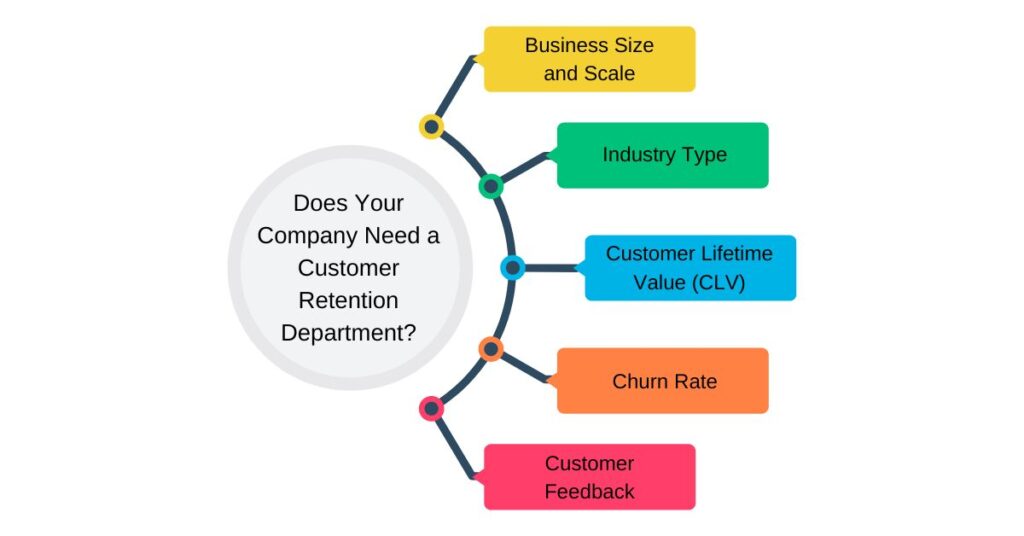The race for customer loyalty has become fiercer than ever. While getting new customers might feel like a quick win, it’s the steady stream of returning customers that truly drives business success. This is where a customer retention department shines, playing a key role in keeping existing customers happy and engaged.
But what exactly does a customer retention department do, and does your company need one? Let’s explore this question and uncover strategies that could change how your business keeps customers coming back.
What is a Customer Retention Department?
A customer retention department is dedicated to keeping current customers engaged and satisfied. Unlike customer acquisition, which aims to attract new customers, retention emphasizes maintaining and nurturing relationships with existing customers.
This department employs various strategies to reduce churn (the rate at which customers stop doing business with you), increase customer lifetime value (CLV), and ensure a positive customer experience.
Does Your Company Need a Customer Retention Department?

Deciding if your company needs a customer retention department depends on several factors:
Business Size and Scale
Larger companies or those with a substantial customer base typically benefit more from a dedicated retention team. This is crucial for managing and analyzing large customer interactions and data volumes.
Industry Type
Businesses with subscription models or those in highly competitive markets should prioritize customer retention. High competition often requires more robust efforts to keep customers loyal.
Customer Lifetime Value (CLV)
Investing in retention strategies can yield significant returns if your CLV is high. A higher CLV means each retained customer provides more long-term revenue.
Churn Rate
A high churn rate indicates a need for better customer retention efforts. Reducing churn can significantly enhance profitability and business sustainability.
Customer Feedback
Consistent negative feedback and low satisfaction scores suggest a dedicated team could improve customer loyalty. Effectively addressing customer concerns can lead to improved satisfaction and retention.
Investing in a customer retention department can be crucial for maintaining long-term business success and building strong customer relationships.
Effective Customer Retention Department Strategies
To help your company effectively retain customers, here are some top strategies inspired by expert advice and successful businesses:
1. Make It Personal
Tailor your approach to each customer. Use the information you have about their preferences and past purchases to create a shopping experience that feels like it’s made just for them.
Send personalized emails with product recommendations based on their browsing history or previous buys. Address customers by name in your communications and reference specific items they’ve shown interest in.
This level of personalization makes customers feel understood and valued, increasing their connection to your brand.
2. Say Thank You with Rewards
Create a rewards program that’s both enticing and easy to use. Develop a points system where customers earn credits for purchases, reviews, or referrals.
Make sure the rewards are things your customers actually want, like discounts on future purchases or exclusive products. Consider offering tiered rewards, where loyal customers can unlock higher levels of benefits. This can encourage repeat business and make customers feel appreciated for their ongoing support.
3. Listen and Act
Actively seek out customer feedback through various channels. Set up short surveys after purchases, encourage reviews on your website, and monitor social media comments. Make it clear that you value their input by responding promptly and thoughtfully.
When you receive suggestions for improvements, take them seriously. Implement changes based on customer feedback and let them know when you do. This shows that you not only listen but also take action, strengthening the bond between your brand and your customers.
4. Be There When They Need You
Invest in training your customer service team to handle issues with empathy and efficiency. Equip them with the tools and authority to resolve problems quickly. Offer various ways for people to reach out, such as phone, email, and chat.
And be sure to follow up after resolving issues to ensure customer satisfaction. By turning potentially negative experiences into positive ones, you can create loyal customers who appreciate your commitment to their happiness.
5. Keep Talking
Maintain regular communication with your customers to keep your brand at the top of their minds. Share company updates, new product launches, and helpful tips related to your products or industry.
Use a mix of communication channels to reach customers where they prefer. This might include email newsletters, social media posts, or even direct mail for a personal touch. The key is to provide value with each interaction, not just sales pitches.
6. Offer Special Deals
Surprise your loyal customers with exclusive offers that make them feel valued. This could be early access to sales, special discounts on their favorite items, or bundled deals created just for them.
Use your customer data to make these offers relevant and timely. For example, you can send discount codes for products that are complementary to recent purchases. These unexpected perks can delight customers and encourage them to keep engaging with your brand.
7. Make New Customers Feel at Home
Create a welcoming onboarding process for new customers. Develop clear, step-by-step guides for using your products or services. Consider creating video tutorials, FAQ sections, or even a dedicated onboarding team to help new customers get started smoothly.
In addition, send follow-up emails to check in and offer additional support. By ensuring a positive initial experience, you set the stage for a long-lasting customer relationship.
8. Build a Community
Foster connections among your customers by creating spaces for them to interact. This could be through online forums, social media groups, or in-person events. Encourage people to share experiences, ask questions, and offer advice to each other.
Take time to actively moderate these communities to ensure they remain positive and helpful. A strong community creates a sense of belonging that ties customers more closely to your brand.
9. Reach Out First
Take a proactive approach to customer service. Use data analytics to predict potential issues or needs your customers might have. For example, if you sell electronics, reach out with troubleshooting tips just before the warranty expires.
Or if you notice a customer hasn’t made a purchase in a while, send them a personalized offer to re-engage them. This proactive care shows customers you’re thinking about their needs and looking out for their best interests.
10. Keep Getting Better
Continuously work on improving your products, services, and overall customer experience. Review customer feedback and sales data regularly to identify areas that need improvement.
When you make adjustments based on customer input, let them know. This could be through email announcements, social media posts, or product update notes. Showing that you’re committed to constant improvement demonstrates your dedication to customer satisfaction.
11. Watch the Numbers
Utilize customer analytics to understand purchasing patterns and predict future behavior. Look for signs that a customer might be losing interest, such as decreased engagement with emails or longer gaps between purchases.
Then, develop targeted campaigns to re-engage these customers before they leave. This might involve special offers, personalized content, or reaching out to ask for feedback. By catching potential issues early, you can often prevent customer churn.
12. Quality Matters
Maintain high standards for everything you offer. Regularly review products and services to ensure they meet or exceed customer expectations. Pay attention to details like packaging, user interfaces, and customer support quality.
Consistency in quality builds trust and reliability, which are key factors in customer retention. When customers know they can count on your brand for excellence, they’re less likely to look elsewhere.
13. Learn from What Customers Do
Implement tools to track how customers interact with your products or website. Analyze this data to understand behavior patterns. Use these insights to improve product designs, streamline your website, or create more effective marketing campaigns.
For example, if you notice customers often buy certain products together, you could create bundle offers or suggest complementary items. This data-driven approach lets you continually enhance the customer experience.
14. Share Helpful Content
Position your brand as a valuable resource by creating and sharing relevant, high-quality content. This could include how-to guides, industry insights, or lifestyle tips related to your products.
Use your blog, social media channels, and email newsletters to distribute this information. By providing genuinely useful content, you establish your brand as an authority in your field. This builds trust and keeps customers coming back to you for both products and information.
Strengthen Customer Relationships for Long-Term Success
Boosting customer loyalty isn’t just about offering great products—it’s about building lasting relationships that keep customers coming back. By implementing these customer retention strategies, your business can reduce churn, enhance customer lifetime value, and create a loyal customer base that supports long-term growth.
A well-structured customer retention department plays a crucial role in this process, ensuring that every interaction is meaningful and that customers feel valued. Start building those connections today, and watch your business thrive through stronger, lasting customer relationships.

We empower people to succeed through information and essential services. Do you need help with something? Contact Us.
Want a heads-up once a week whenever a new article drops?







